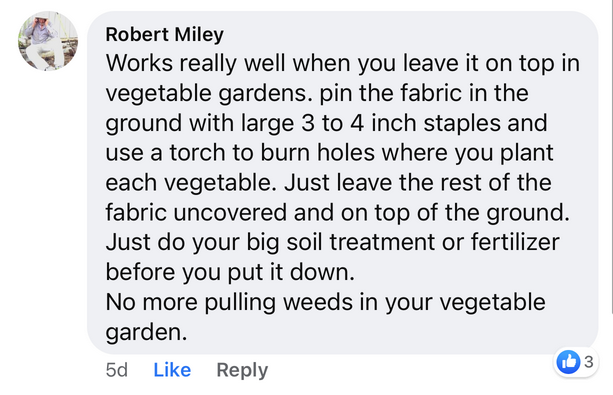Should I Install Landscape Fabric?
Long answer short, probably not...
Here’s the deal, landscape fabric is used by many gardeners to cut down on gardening maintenance tasks.
But, should you install the fabric if you haven't already?
As a professional gardener, I've seen many gardens during my 14 year career.
Personally, I discourage my clients from using landscape fabric.
And I am not alone, check this out:
43% of landscapers surveyed say it's more trouble than it’s worth.
In my experience, here are the 6 reasons why landscapers feel this way:

1. It compacts the soil.
In order to truly be healthy, soil needs to be crumbly and loose. Loose soil allows for nutrients, water and even air to reach down in the soil and help plants to grow.
This is the type of soil where plants can spread their roots and grow without too much work.
But get this, I've noticed that soil underneath the landscape fabric does not stay crumbly and loose. Rather, the soil becomes hard and compact.
Worst of all, this makes digging and planting very difficult!

2. Weeding Gets Harder
Weeding is a nightmare. While the landscape fabric will reduce the number of weeds in your garden, it won't entirely get rid of them.
The weeds that do manage to get through the fabric are usually horrible enmeshed with the fabric itself.
After a year or two, you may end up with a bigger problem than you started with.
This means it's very hard to remove the weeds. Often times, removing the weed entirely means ripping the landscape fabric.

3. Contains Harmful Chemicals
Here's the deal, landscape fabric contains petroleum and other chemicals.
Most gardening experts advise gardeners to avoid using petroleum products or products with chemicals around plants.
This is especially true for those plants that are edible.

4. Landscape fabric is expensive.
Landscape fabric itself is costly.
Then there is the cost of installing the fabric, cutting out each hole for plants, this takes a considerable amount of time.
Furthermore, in order to properly install the fabric, you need pins to hold the fabric down. This further increases the cost.
It gets worse, it may be necessary to patch the fabric or install additional pins throughout the year.

5. There's not a lot of room for error.
Gardeners are known for changing their minds. One season you may want a new plant in a certain place.
This may change from year to year. As plants grow, they will need to be divided in order to keep the original plant healthy.
Both of these tasks become incredibly difficult when landscaping fabric is present.
Long story short, changing location and dividing plants become a time consuming chore, and you will likely up-heave much of the landscape fabric in the process.

6. Re-seeding is almost impossible.
One of the joys of gardening is watching which plants have re-seeded themselves in your yard year after year.
Unfortunately, when you use landscape fabric, it's very difficult for plants to re-seed themselves.
Even worse, bulbs can get pushed around and may not return, not to mention if you want to add more latter.
Alternatives to Landscape Fabric
Fortunately there are many alternatives to landscape fabric which can prevent weeds more effectively without so many side-effects.

Alternatives to landscape fabric include:
- Installing a thick layer of wood chips or mulch,
- Using a layer of newspaper or cardboard,
- Weeding regularly,
- Corn gluten for weed control,
- Preen or Roundup.
Not only are these solutions relatively inexpensive, but they are attractive and will not affect the soil quality in a negative way. Mulching your garden beds with a thick layer of wood-chips is likely the most common method for weed control.

Pros and Cons of Landscape Fabric
To help you make an informed decision, here is a summarized table of the benefits and drawbacks of using landscape fabric in gardening and landscaping:
| Aspect | Pros | Cons |
|---|---|---|
| Weed Control | Reduces initial weed growth, less need for herbicides. | Does not prevent long-term weed growth; weeds can root into the fabric. |
| Soil Health | Reduces moisture evaporation from the soil. | Hinders water and air penetration, leading to unhealthy soil conditions. Blocks beneficial soil organisms and nutrients. |
| Cost | Long-lasting in some applications, reducing need for replacements. | Initial and ongoing costs can be high; expensive to install properly. |
| Installation | Suppresses weeds under walkways and patios effectively. | Time-consuming to install, especially around existing plants. Difficult to modify once in place. |
| Environmental Impact | Some types are made from recycled materials. | Often contains petroleum and other chemicals; not biodegradable. |
| Aesthetics | Can be covered with mulch for a neat appearance. | Becomes unsightly over time as it frays and surfaces through mulch. |
Exceptions When Landscape Fabric May Be Useful
Of course there are still times when landscape fabric may be useful.
Some landscaping companies such as K&S Landscaping out of Chicago, recommend using landscape fabric under stone.

And it's true, many landscapers do utilize landscape fabric in stonescapes...
But remember to use pins or you may end up with this:

One of the respondents, Robert Miley, said that he likes to use landscape fabric in his vegetable gardens. By using large 3-4 inch staples to hold the fabric down and a torch to put holes exactly where he needs them.
Check out what he had to say:

How does landscape fabric affect soil health?
Landscape fabric can lead to soil compaction, preventing air, water, and nutrients from reaching plant roots effectively.
TLDR: Landscape Fabric - To Use or Not?
Landscape fabric, often used to reduce gardening maintenance, might not be the best choice according to a seasoned professional gardener with 14 years of experience.
Here's why:
- Soil Compaction: Landscape fabric leads to hard, compact soil, hindering plant growth and making gardening tasks like planting and digging challenging.
- Weeding Woes: While it reduces the number of weeds, those that penetrate the fabric become entwined, making removal difficult and potentially worsening the problem.
- Chemical Concerns: Containing harmful chemicals like petroleum, landscape fabric poses risks, especially around edible plants.
- High Cost: Beyond the expense of the fabric itself, additional costs for installation, maintenance, and necessary accessories like pins add up.
- Limited Flexibility: Gardening involves frequent changes, like relocating plants or dividing them for health. Landscape fabric makes these tasks time-consuming and labor-intensive.
- Re-seeding Restrictions: The fabric hinders natural re-seeding of plants, disrupting the garden's organic growth and making planting new bulbs difficult.
- Alternatives to Consider: Instead of landscape fabric, options like wood chips, mulch, newspaper, cardboard, regular weeding, and natural weed control products offer effective, eco-friendly solutions.
Exceptions: In certain scenarios, like under stones in landscaping, landscape fabric can be useful, provided it's installed correctly.
The Bottom Line on Using Landscape Fabric
As a gardener, I suggest that homeowners use another method to make gardening easier.
There are plenty of alternatives to landscape fabric, and in my experience these options are much better than using landscape fabric.

If you are needing a professional lawn services to help with mulching, give GreenPal a spin. Our lawn care pros can help you find the best solution for your gardens, whether you want landscape fabric or not.




 Share
Share





